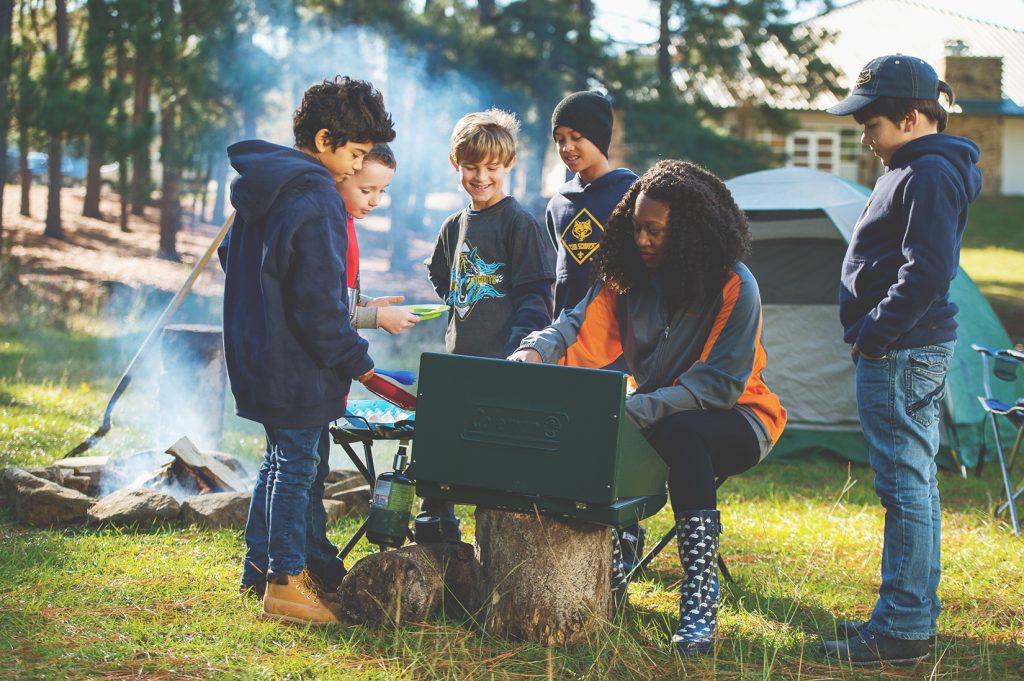
UNIT BUDGET PLANNING

WHY PLAN A UNIT BUDGET?
The activities a pack, troop, or crew is able to participate in hinges on their finances – both how much funds are available as well as the plan on how those funds are used. It is important to plan out your unit’s budget in advance to match the plans of your unit’s program calendar. There are several components that go into managing a unit’s account and budget throughout the year. This guide can help as starting place for some of the basics for planning your unit’s budget.

BUDGETING BASICS
If your job is the management of your unit’s money, your first steps are the basics: basic income and basic expenses. These basic items are the same whether you are managing a Cub Scout pack, a Boy Scout troop, or a Venturing Crew. It doesn’t matter if you are located in Cincinnati, Ohio, Covington, Kentucky, or Honolulu, Hawaii. The basics should be planned and budgeted first and will form the foundation of the amount of income your unit needs to operate and the amount of funds available for your expenses.
Once you develop a sound budget for the basics, you can add other things such as your individual programming and equipment needs. The programs your unit wants to participate in and the materials needed for your regular meetings and special outings are part of the other expenses built upon the basic expenses. You will need to determine the costs of these items to set the amount of income required beyond the basic registration, insurance, and charter fees.
Download our budget template below to help walk you through the steps.

BASIC EXPENSES
- Unit Charter Fee. Every unit is required to pay an annual charter fee of $75. This fee is submitted with the unit’s charter application and helps defray the expenses for the general liability insurance program by providing approximately 25 percent of the funds required to maintain insurance coverage for all chartered organizations and leaders.
- Registration. When a scout joins, normally the unit asks them to pay the full $66 national registration fee regardless of the number of months remaining in the unit’s charter year. The unit sends to the council the pro-rated amount for those remaining months.The Balance of the scout’s fee is kept in the unit treasury to supplement their dues in paying the next full year’s fee. This procedure ensures prompt registration at charter renewal time. Note that fees are figured on a monthly basis:
- 1 month=$5.50
- 2 months=$11.00
- 3 months=$16.50
- 4 months=$22
- 5 months $27.50
- 6 months $33.00
- 7 months $38.50
- 8 months $44.00
- 9 months $49.50
- 10 months $55.00
- 11 months $60.50
- 12 months $66.00
Scouts’ Life. Scouts’ Life magazine, the official publication of the Boys Scouts of America, is available to all members at $12.00 (half the regular rate). Every Scout is encouraged to subscribe to Boys’ Life because of the quality of the reading and many articles relate to your unit’s monthly program. It is part of a child’s growth in Scouting too, and research proves they will stay in longer and advance further if they read Boys’ Life. If the reserve funds will allow, the new youth, during the charter year should be signed up for Boys’ Life on a pro- rated basis.
When reserve funds do not pay for the subscription, then the child or their parents may be asked for the amount. They should understand that the Boys’ Life subscription cost is not a required part of the national membership fee.
Unit Accident Insurance. Each unit should be covered by unit accident insurance to help meet the costs of medical care if accidents occur. This $5.50 is paid with the member’s application or paid altogether during the charter renewal.
- Activities and Camp. Be sure to include your planned unit activities for the year. This might include campouts, Blue & Gold banquets, Red’s games and more. Also include your summer camp plans. Is the unit helping to offset the cost of summer camp. Remember large district, council, and national events as well such as Cuboree, Peterloon, and National Jamboree.
- Reserve Fund. A reserve fund should be established by a gift or loan from the chartered organization, members of the committee, or by a unit money-earning project. The reserve fund should meet unexpected expenses that occur before dues are collected or other money is earned. A new member’s initial expenses may also be met from the fund. A small portion of each boy’s basic expenses is budgeted to maintain this fund. If the reserve fund falls below this amount, it should be restored through a money-earning project or other means.
Other Basic Expenses. These basic expenses include insignia of membership and rank for each Scout to ensure prompt recognition, and literature required by unit adult and youth leaders. Because service to others is fundamental in Scouting, the budget should include a goodwill project, Good Turn, or a gift to the World Friendship Fund.
When all of the these basic expense items are broken down per member, it should look something like this:
| Registration | $66.00 |
| Boy’s Life | $12.00 |
| Accident Insurance | $5.50 |
| Reserve Fund | $1.00 |
| Other Basic Expenses | $5.50 |
| TOTAL | $35.25 |
This same expense table can be used for registered adults.

OTHER EXPENSES
- Program Materials. Each unit needs to provide a certain amount of program materials. For example, it should have a United States flags, a unit flags, and equipment and supplies for its regular program. Camping equipment, service project equipment, or Court of Honor or Blue and Gold materials might also be needed.
- Activities. The size of the budgeted amount for activities depends on the unit program. Usually, such activities as Cub Scout pinewood derbies, Scout hikes, or camping are financed by the scout and their family over and above the dues program.

INCOME
- Dues. Most people agree that the habit of regularly meeting financial obligations is desirable. The finance plan of any unit should include participation by a boy or girl in a regular dues plan. An annual unit fee, too often completely contributed by parents, does little to teach a youth responsibility. However, if they have to set aside a little each week for a desired item such as dues, they learn how to budget their own income.
Paying dues regularly is not easy, but it does help develop character in an individual child. It teaches responsibility and a wholesome attitude toward earning their own way.
The weekly or monthly dues envelopes for Cub Scout dens and Scout patrols provide a handy means of recording dues for youth who pay on a regular basis, catch up on back dues, or pay in advance. If a boy or girl is behind in dues, adult leaders should find out why. Adult leaders may also help provide a solution through individual work projects.
In some units, youth earn their dues by participating in unit money-earning projects. It is important that such work be credited to the boy or girl personally rather than to the unit as a whole so he will develop a sense of personal responsibility and participation.
Regardless of your dues collection plan, or how many months or weeks they are collected, individual dues should cover the basic expenses, as shown in the recommended budget. You may also want dues to cover a part of the program and activity budget.
- Money-Earning Projects. A well-rounded unit program requires supplemental income. It might come from the sale of a product or a project involving the talents, participation, or efforts of the unit members of families.
We suggest the popcorn sale because it is a proven fundraiser that a majority of our units use. Learn more about popcorn here.
Money-earning projects require the submission of the Unit Money-Earning Application, No. 34427, to the Scout Achievement Center. To ensure conformity with all Scouting standards on money earning, leaders should be familiar with the 10 guides listed on the back of the application and in the financial record books.

UNIT ACCOUNTS
As a service to its units and customers, the Dan Beard Council accepts advanced deposits to be held by the council in a custodial account in the name of the unit. The unit account can be used for supplies, registration, Boys’ Life, camp registration fees, or activity fees. Funds from the unit account can be used in the Dan Beard Scout Shop – you can now simply request your balance at the Scout Shop desk with one of the store clerks to make payment.
If you wish to use the unit account service, you may simply bring a check or cash in the amount you want to have deposited into the account and a list of names of the people in your unit you wish to have able to use the money in the account. Only those listed will be able to use the account. Only the Committee Chairman, Cubmaster, Scoutmaster, or Post Advisor may change the names on the account and this should be done in writing.
Since this is not a tab, only the amount of money deposited in the account may be spent. No overdrafts are permitted.
Monthly statements are not issued so it is the responsibility of the users of the account to keep receipts and balances. However, if there is ever a question we will be happy to run a balance sheet, or tell you what the balance is in the account.
Every unit in the council has the capability to have an account and one can be started at any time simply with a deposit.
Every unit budget works a little bit differently, but the fundamentals are the same. Using the information from the previous pages, the following template should be helpful in beginning to plan your unit’s budget for the year:
Additional information concerning unit budget plans, the treasurer’s job, camp savings, forms, and records can be found in: Pack Record Book, No. 33819; Troop/Team Record Book, No. 34508; Cub Scout Leader book, NO. 33221; and Varsity Scout Leader Guidebook, No. 34827. These items are available through the Scout Shop.
- Pack Operating Budget Worksheet (DBC Version, National BSA Version
 )
) - Troop Operating Budget Worksheet (DBC Version, National BSA Version
 )
) - Unit Money Earning Application
- Planning Your “Ideal Year of Scouting” Program Budget
 )
)